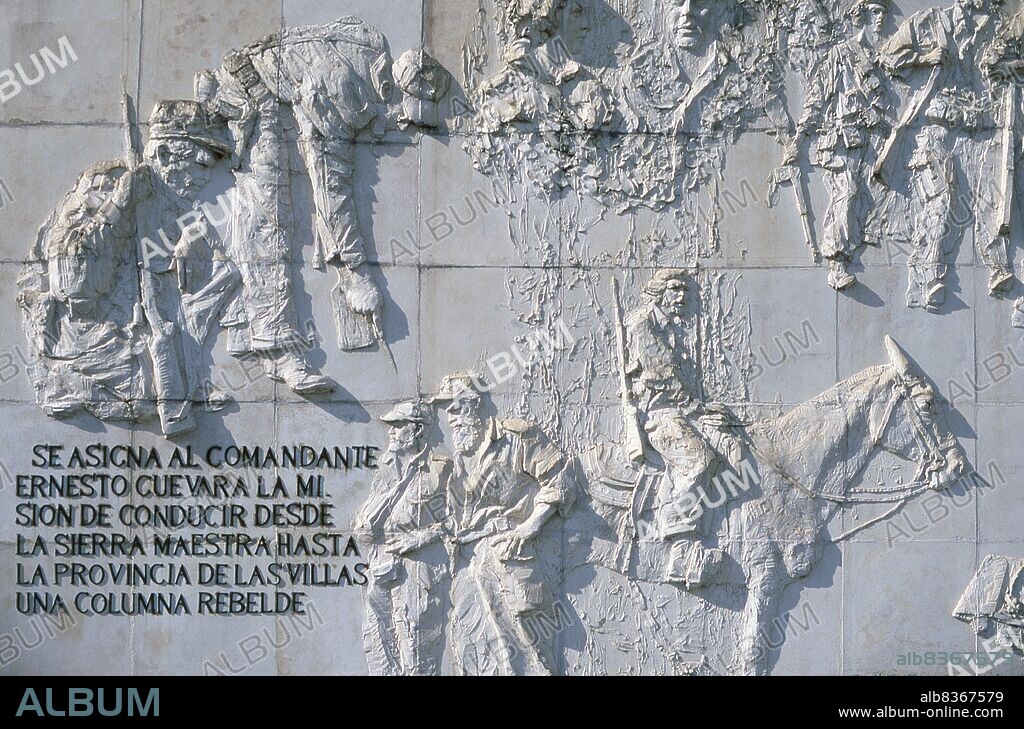alb8367579
Cuba: The Che Guevara Mausoleum (detail), a monument dedicated to the memory of Argentinean revolutionary Che Guevara, Santa Clara, Villa Clara Province. It contains the remains of Guevara and twenty-nine of his fellow combatants killed in 1967

|
Ajouter à une autre Lightbox |
|
Ajouter à une autre Lightbox |



Avez-vous déjà un compte? S'identifier
Vous n'avez pas de compte ? S'inscrire
Acheter cette image

Titre:
Cuba: The Che Guevara Mausoleum (detail), a monument dedicated to the memory of Argentinean revolutionary Che Guevara, Santa Clara, Villa Clara Province. It contains the remains of Guevara and twenty-nine of his fellow combatants killed in 1967
Légende:
Voir la traduction automatique
While living in Mexico City, Guevara met Raúl and Fidel Castro, joined their 26th of July Movement, and sailed to Cuba aboard the yacht, Granma, with the intention of overthrowing U.S.-backed Cuban dictator Fulgencio Batista. Guevara soon rose to prominence among the insurgents, was promoted to second-in-command, and played a pivotal role in the victorious two year guerrilla campaign that deposed the Batista regime.
. Following the Cuban Revolution, Guevara performed a number of key roles in the new government. These included reviewing the appeals and firing squads for those convicted as war criminals during the revolutionary tribunals, instituting agrarian reform as minister of industries, helping spearhead a successful nationwide literacy campaign, serving as both national bank president and instructional director for Cubas armed forces, and traversing the globe as a diplomat on behalf of Cuban socialism. Guevara left Cuba in 1965 to foment revolution abroad, first unsuccessfully in Congo-Kinshasa and later in Bolivia, where he was captured by CIA-assisted Bolivian forces and executed.
. Following the Cuban Revolution, Guevara performed a number of key roles in the new government. These included reviewing the appeals and firing squads for those convicted as war criminals during the revolutionary tribunals, instituting agrarian reform as minister of industries, helping spearhead a successful nationwide literacy campaign, serving as both national bank president and instructional director for Cubas armed forces, and traversing the globe as a diplomat on behalf of Cuban socialism. Guevara left Cuba in 1965 to foment revolution abroad, first unsuccessfully in Congo-Kinshasa and later in Bolivia, where he was captured by CIA-assisted Bolivian forces and executed.
Crédit:
Album / Universal Images Group / David Henley / Pictures From History
Autorisations:
Modèle: Non - Propriété: Non
Questions sur les droits?
Questions sur les droits?
Taille de l'image:
5029 x 3320 px | 47.8 MB
Taille d'impression:
42.6 x 28.1 cm | 16.8 x 11.1 in (300 dpi)
Mots clés:
ARGENTINE • ARMEE: SOLDATS • ART ARGENTIN • AUTEUR • AUTEURS • COMMUNISTE • CUBA • DOCTEUR • DOCTEURS • GUERILLA • GUEVARA, ERNESTO • MARXISTE • MEDECIN • MEMORIAL • MILITAIRE • PROVINCE • PROVINS • RÉVOLUTIONAIRE • REVOLUTIONNAIRE • RÉVOLUTIONNAIRES • SOLDAT DE L'ARMEE POPULAIRE NATIONALE • SOLDAT • VIE MILITAIRE ET ARMEMENT
 Pinterest
Pinterest Twitter
Twitter Facebook
Facebook Copier le lien
Copier le lien Email
Email
